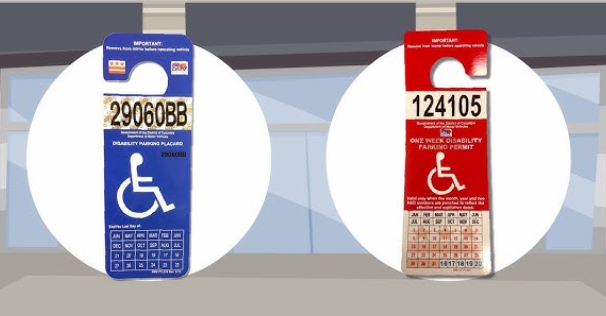
What Are the Different Handicap Parking Placard Colors?
Introduction
Understanding the different handicap placard colors is essential for individuals who rely on these permits for accessible parking. Each placard color serves a specific purpose, with eligibility criteria varying by state and need. Whether you are applying for a placard or simply want to ensure compliance with local regulations, this guide will clarify the distinctions among blue, red, green, and temporary placards.
This article will discuss:
The meaning behind each placard color
Who qualifies for each type
The validity and renewal process
How to apply for a disability tag online with HandicapMD.com
Understanding Handicap Placard Colors
Different states issue color-coded placards to indicate the type of parking privileges available to individuals with disabilities.
Handicap placards are color-coded to signify the type of parking privileges granted to individuals with disabilities. The color system helps law enforcement, parking officials, and the public easily distinguish between different types of permits and the duration of their validity. Although the specific colors and regulations may vary by state, the most commonly issued placards follow a standardized color scheme.
Types of Handicap Placards and Their Meanings
? Blue Placards – Permanent Disability
A blue disability tag is issued to individuals with permanent disabilities that significantly impair their mobility. These placards allow parking in designated accessible spaces and may come with additional privileges, such as metered parking exemptions in some states.
- Eligibility: Issued to individuals with long-term or permanent mobility impairments, including but not limited to paralysis, amputations, severe arthritis, and conditions affecting the ability to walk.
- Expiration & Renewal: Typically valid for several years (varies by state). Renewal often requires recertification from a medical professional or an automatic renewal process, depending on state regulations.
- Usage: Must be displayed while parked in designated spaces but should not be used when the permit holder is not in the vehicle.
? Red Placards – Temporary Disability
A red disability tag is designated for individuals with temporary disabilities resulting from injuries, surgeries, or short-term medical conditions that affect mobility.
- Eligibility: Issued to individuals recovering from conditions such as broken bones, post-surgical mobility restrictions, or short-term illnesses that significantly limit movement.
- Expiration & Renewal: Typically valid for six months to one year, depending on the state. These placards cannot always be renewed—a new application with updated medical documentation may be required.
- Usage: Provides the same parking privileges as blue placards but is intended for short-term use.
? Green Placards – Organizational Vehicles
A green disability tag is assigned to organizations or facilities that regularly transport individuals with disabilities. These placards are often used by hospitals, nursing homes, rehabilitation centers, and nonprofit organizations that assist disabled individuals.
- Eligibility: Issued to organizations providing transportation services for disabled individuals rather than personal use.
- Expiration & Renewal: Varies by state, typically requiring periodic renewal.
- Usage: Must be used exclusively for transporting individuals with disabilities and should not be used for personal employee parking.
? Purple Placards – Disabled Veteran Parking
A purple disability placard is reserved for disabled veterans who have sustained service-connected disabilities and meet the eligibility requirements set by their state’s Department of Motor Vehicles (DMV) or Department of Veterans Affairs (VA).
- Eligibility: Available to veterans with a certified service-related disability as determined by the VA. Some states may require a specific disability rating for eligibility.
- Expiration & Renewal: Typically valid for several years, but renewal policies vary by state. Veterans may need to provide proof of continued eligibility.
- Usage: Grants parking privileges similar to blue permanent disability placards but may include additional benefits, such as fee exemptions at certain public parking facilities.
Other Specialized Placards
Some states issue additional placards with unique colors or features, including:
- Gold Placards: Certain states offer gold disability tag for individuals with specific disabilities, such as legal blindness or severe neurological conditions.
- Orange Placards: Less common but sometimes used for temporary, short-term permits that last a few weeks or months.
- Dual-Purpose Placards: Some states issue placards that combine multiple classifications, such as a disabled veteran placard with permanent disability benefits.
Important Considerations for Handicap Placard Holders
- Proper Display: disability tags should be hung from the rearview mirror or placed on the dashboard while the vehicle is parked in an accessible space.
- Fraud Prevention: It is illegal to misuse, alter, or lend a tag to someone who is not the registered holder. Violators may face fines, revocation of privileges, or legal penalties.
- State-Specific Rules: While the general color-coding system applies in most states, it’s always best to check with your state’s DMV or transportation authority for specific regulations.
By understanding what each placard color represents, individuals with disabilities can ensure they use their parking privileges correctly while avoiding potential violations. If you need a new or renewed disability tag, consider applying through HandicapMD.com for an easy and hassle-free process.
Each of these colors corresponds to specific eligibility criteria, expiration dates, and renewal requirements.
Blue Handicap Placards: Permanent Disability
A blue handicap tag is issued to individuals with long-term or permanent disabilities that significantly impact their mobility and ability to navigate public spaces without assistance. These tags grant special parking privileges, allowing holders to park in designated accessible spaces closer to building entrances and, in some states, access additional benefits such as metered parking exemptions or extended parking durations.
Understanding who qualifies, how long the tag remains valid, and how to renew it is crucial for ensuring continued accessibility and compliance with state regulations.
Who Qualifies for a Blue Handicap Placard?
Eligibility for a permanent disability tag is based on medical conditions that severely limit mobility or function. While exact qualifications may differ by state, most follow similar eligibility guidelines.
Individuals typically qualify for a blue disability tag if they have one or more of the following conditions:
Mobility Impairments
- Inability to walk more than 200 feet without stopping due to pain, exhaustion, or other medical reasons.
- Use of mobility aids such as a cane, crutch, walker, wheelchair, prosthetic limb, or other assistive devices.
- Amputation or severe loss of function in one or both legs.
Respiratory Conditions
- Severe lung disease or other chronic respiratory conditions that significantly impair breathing capacity.
- Dependence on supplemental oxygen or other breathing assistance devices.
Cardiac Conditions
- Severe heart disease, specifically classified as Class III or Class IV according to the American Heart Association’s (AHA) Functional Classification System:
- Class III: Individuals experience marked limitation of physical activity and become fatigued, short of breath, or develop chest pain with mild exertion.
- Class IV: Individuals are unable to perform any physical activity without experiencing discomfort and may have symptoms even while at rest.
Neurological & Musculoskeletal Disorders
- Severe arthritis or degenerative joint disease that impairs mobility.
- Multiple sclerosis (MS), Parkinson’s disease, cerebral palsy, ALS (Lou Gehrig’s disease), or other neurological disorders affecting motor function.
- Spinal cord injuries that result in paralysis or severe movement restrictions.
Visual Impairments
- Legal blindness, as defined by federal or state laws, which may impact safe mobility and navigation.
Other Qualifying Conditions
Some states include additional qualifying conditions, such as:
- Severe kidney disease requiring regular dialysis treatment.
- Chronic pain disorders that result in substantial impairment in mobility.
- Severe balance disorders or conditions affecting inner ear function that make walking unsafe.
If you are unsure whether your condition qualifies for a permanent disability tag, you can consult a licensed medical professional or apply for an evaluation through HandicapMD.com.
How Long Is a Blue Handicap Placard Valid?
The validity of a blue disability tag varies by state but is generally issued for four to six years. The exact expiration date will be indicated on the tag itself.
State-Specific Renewal Policies
- Some states offer automatic renewal, meaning that eligible individuals receive a new tag without needing to submit additional paperwork.
- Other states require a recertification process, where individuals must provide updated medical documentation from a licensed healthcare provider to confirm continued eligibility.
It is important to check with your state's Department of Motor Vehicles (DMV) or equivalent agency to determine specific requirements regarding expiration and renewal.
How to Renew a Blue Handicap Placard
If your permanent disability tag is set to expire, you must complete the renewal process before it becomes invalid. While renewal procedures may vary by state, they generally involve the following steps:
Step 1: Submit a Renewal Application
- Sign up at HandicapMD.com
- Complete your state's DMV disability tag renewal form we will email to you
- Some states allow submission of the completed form for online renewals, while others may require a paper application submission via mail or in person.
Step 2: Provide Medical Certification (If Required)
- While some states allow automatic renewals, others may require an updated medical certification from a licensed physician, physician assistant, chiropractor, or other approved healthcare provider.
- Medical documentation should confirm that the individual still meets the eligibility criteria for a permanent disability placard.
Step 3: Pay Any Applicable Fees
- Many states waive renewal fees for individuals with permanent disabilities. However, some may charge a small administrative fee for processing the application.
- Certain states offer lifetime tags, which require no renewal fees after an initial medical certification.
Step 4: Receive and Display Your New Placard
- Once approved, the DMV will issue a new tag with an updated expiration date.
- Ensure that you properly display the tag when parked in accessible spaces, but remove it when driving to prevent obstruction of your view.
Apply Online for a Blue Handicap Placard with HandicapMD.com
If you need a permanent disability tag but don’t want to deal with the hassle of long wait times, in-person DMV visits, or confusing paperwork, HandicapMD.com makes the process easy.
Why Choose HandicapMD.com?
✅ Licensed Medical Providers – Get your certification from a doctor who understands ADA eligibility requirements.
✅ 100% Online Process – No need to visit a doctor or DMV in person.
✅ Fast & Hassle-Free – Submit your application in minutes and receive your documentation quickly.
✅ Secure & HIPAA-Compliant – Your medical information is protected and confidential.
? Apply online today at HandicapMD.com and get your blue disability taghassle-free! ?
Red Handicap Placards: Temporary Disability
A red disability tag is issued to individuals who have temporary medical conditions that significantly limit their mobility for a short period. These tags allow holders to park in designated accessible parking spaces while recovering from an injury, surgery, or medical condition that impairs movement.
Unlike blue disability tags, which are issued for permanent disabilities, red tags are designed for short-term use and are typically valid for up to six months. Depending on state regulations, an extension or renewal may be available if the temporary disability persists beyond the original expiration date.
Who Qualifies for a Red Handicap Placard?
Eligibility for a temporary disability tag is based on medical conditions that impair mobility for a limited time. While qualifications may vary by state, the following conditions are commonly accepted as valid reasons for obtaining a red tag:
Post-Surgical Recovery
Individuals who are recovering from major surgeries that impact their ability to walk or move without assistance may qualify for a temporary tag. These include:
- Knee replacement surgery
- Hip replacement surgery
- Spinal surgery (including herniated disc surgery and spinal fusion)
- Foot or ankle surgery (such as Achilles tendon repair or bunionectomy)
- Rotator cuff or shoulder surgery (if mobility is restricted and crutches or a wheelchair are required)
Severe Bone Fractures and Orthopedic Injuries
Individuals with broken bones, dislocations, or severe sprains that require immobilization, crutches, a wheelchair, or a walker often qualify for a red disability tag.
- Fractured leg, ankle, or foot bones
- Severe sprains or torn ligaments
- Pelvic fractures or hip dislocations
- Recovery from a cast, brace, or external fixator
Pregnancy-Related Complications
Pregnant individuals who experience serious mobility limitations due to medical complications may qualify for a temporary disability tag.
Common pregnancy-related conditions that may warrant a red tag include:
- Placenta previa – A condition where the placenta blocks the cervix, leading to restrictions on walking and movement.
- Symphysis pubis dysfunction (SPD) – A painful condition affecting the pelvic joints, making walking difficult.
- Severe edema or swelling – Excessive swelling in the legs and feet that affects mobility.
- Preterm labor risks – Cases where limited movement is medically advised to prevent premature birth.
Injuries and Temporary Mobility Limitations
Individuals recovering from accidents, sports injuries, or temporary medical conditions that impair walking ability may be eligible for a red tag.
- Concussion or traumatic brain injury (TBI) causing balance issues.
- Post-stroke recovery if mobility is affected but expected to improve.
- Short-term paralysis due to nerve damage or temporary neurological disorders.
- Burn injuries that restrict movement.
If you’re unsure whether your condition qualifies for a temporary handicap placard, consult a licensed healthcare provider or apply online through HandicapMD.com for an evaluation.
How Long Is a Red Handicap Placard Valid?
Typical Duration of Temporary Placards
Most temporary disability tags are valid for up to six months, but the specific duration is determined by state laws and the severity of the condition. Some states issue shorter-term permits, such as three-month tags, while others allow validity periods of up to one year.
Can a Red tag Be Extended?
In some states, if an individual’s temporary disability lasts beyond the expiration date of the original tag, an extension or renewal may be available. However, in many cases, a new application and updated medical certification from a licensed healthcare provider are required.
How to Renew a Red Handicap Placard
If a temporary disability has not fully healed by the time a red tag expires, individuals may need to renew or reapply for continued parking privileges. The renewal process varies by state but typically involves the following steps:
Step 1: Determine if Renewal or Reapplication is Required
- Some states allow a direct renewal of a temporary tag, requiring only a renewal form.
- Other states require a completely new application with updated medical certification from a doctor.
Step 2: Obtain a Renewal Form from the DMV
- Visit the state DMV website or a local office to download the appropriate renewal or reapplication form.
- Some states offer online renewal options.
Step 3: Provide Updated Medical Certification (If Required)
- Many states require a new medical evaluation to confirm that the temporary disability still impairs mobility.
- Certification must be signed by an approved medical professional, such as a physician, surgeon, chiropractor, podiatrist, or nurse practitioner.
Step 4: Submit the Application and Pay Fees (If Applicable)
- Some states charge a small renewal or processing fee, while others waive fees for individuals with verified medical conditions.
- If your state requires an in-person renewal, you may need to bring identification and your expired tag to the DMV office.
Step 5: Receive and Display the New tag
- Once the application is approved, a new red disability tag will be issued with a new expiration date.
- Always ensure the tag is properly displayed while parked in an accessible space and removed when driving.
Need a Temporary Disability Placard? Get One Online with HandicapMD.com!
If you have a temporary medical condition that affects your mobility, HandicapMD.com makes it fast and easy to obtain a red disability tag without long DMV lines or paperwork confusion.
Why Use HandicapMD.com?
✅ Quick & Simple Process – Apply online in just minutes!
✅ Certified Medical Evaluations – Approved by licensed doctors who understand ADA guidelines.
✅ No DMV Hassle – We handle the paperwork for you.
✅ HIPAA-Compliant & Secure – Your personal medical information is safe.
? Apply today at HandicapMD.com and get your red disability tag hassle-free! ?
Green Handicap Placards: Organizational Vehicles
Who Qualifies for a Green tag ?
Green disability tags are designated for organizations that transport disabled individuals. These include:
Nursing homes and care facilities
Nonprofit organizations providing disability transportation
Medical transport services
How Long Is a Green tag Valid?
These tags are typically issued on an annual basis and must be renewed yearly to remain valid.
How to Renew a Green tag
Renewing an organizational disability tag usually requires:
Verification of the organization’s status
Submitting an updated application with proof of continued transport services
Payment of any renewal fees
Does your organization need a green tag? HandicapMD.com can help simplify the process.
Purple disability tags: Disabled Veteran Parking
Who Qualifies for a Purple tag?
Some states issue purple disability tags exclusively for disabled veterans. Eligibility often includes:
Service-connected disabilities
VA-issued documentation confirming permanent disability
Amputation or severe mobility impairment due to military service
How Long Is a Purple tag Valid?
Purple tags for disabled veterans generally follow the same validity periods as blue tags (permanent disability) and may be valid for up to six years.
How to Renew a Purple tag
Renewing a disabled veteran tag involves:
Submitting updated VA disability certification
Completing a renewal application
Paying applicable state fees
Need a disabled veteran tag? Apply through HandicapMD.com today!
Other Specialized Placards
Some states issue additional placards, such as:
Orange Placards – Reserved parking for individuals with severe visual impairments (e.g., in New York)
Yellow tags – Used in some states for individuals with limited mobility but not qualifying for permanent status
How to Apply for a disability tag Online
Applying for a disability tag has never been easier! With HandicapMD.com, you can complete the process online without visiting a DMV.
Steps to Apply Online:
Complete a quick evaluation with a HandicapMD licensed physician.
Receive your completed medical certification.
Submit your application to the DMV.
Receive your tag via mail!
Why Choose Us?
Fast online evaluations
HIPAA-compliant platform
No in-person DMV visits required
Trusted and experienced doctors
Conclusion
Understanding what different handicap placard colors mean ensures compliance with accessibility laws and helps individuals receive the parking privileges they need. Whether you need a blue placard for permanent disabilities, a red placard for temporary conditions, a green placard for an organization, or a purple placard for disabled veterans, HandicapMD.com makes the application process simple and stress-free.
.png)





